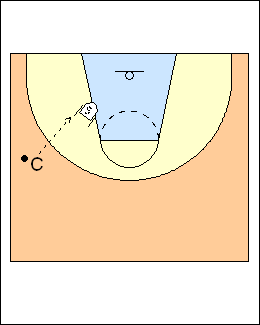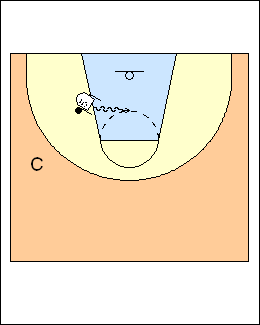Post dribble moves
 | 1 Christine Stapleton coachesclipboard.ca Gain position - foot fight and keep defence on back, or face defence, step in, split defender's feet, sit and spin to get defender on back. Use triceps and elbows to keep defender there. Catch before moving position, then look under the ball. Check there is no double-team coming, attack the dotted circle, dribble with the baseline hand. coachesclipboard.ca A back-down is when a player catches the ball off the lane, turns his/her back to the defender, looks over the inside shoulder and begins to dribble towards the middle of the lane with a crab dribble, looking to make a play. At the highest levels of play most post play comes from the back down game; because the lane is wider, as in FIBA and the NBA, or the play is more physical and players are forced off the lane. There are four parts - the catch, the dribble, attacking the middle and reading, and the finish. The catch - in typical post play the player tries to bury their defender as close to the basket as possible and to catch the post entry pass with their back to the basket. In the back down game the player catches the ball off the lane and usually with their back to the baseline. With the back to the baseline the defender has less opportunity to bother the entry pass to the post because he/she is further from the ball. The ball is usually passed softly into the post using either a bounce pass or an air pass with arc, these passes allow the post player to release and go get the ball. It is not a big concern to give up ground on the catch because the real estate lost on the catch is made up on the dribbles. Though it can be easier to double team, with the ball-side defender, when the ball is caught off the lane, this also can makes the rotations harder for the defenders because they must cover more ground. The dribble - the goal is to get closer to the basket by forcing the defender into the lane, with the use of the 1-3 dribbles. The player must be low and protect the ball by dribbling the ball between their feet, but nearest the back foot - this is the crab dribble (there is going to be contact, which is why the player stays low). In most cases, the offensive player bumps their lead shoulder into the chest of the defender and forces the defender to move back. The offensive player must make sure he/she does drive into the defender too hard; otherwise an offensive foul may be called. If the player is not low during the crab dribble, the contact may force the player off balance, or not enable him/her to knock the defender back into the lane. As the players bang into each other balance becomes critical. The defender can be working so hard to stop the offensive player from getting closer to the basket that they lean forward and lose balance allowing the offensive player to spin or drop step easily to the baseline, e.g. for a turnaround jump shot. |
 | 2 Use the other hand as a sensor, if the defender leans on it, he is playing high, if not he is staying low. If he is up high to stop middle penetration, reverse to baseline; if low, attack the top foot. When a defender sags off a player further out who does not want to shoot, an option is to use a back-down or crab dribble. Make the defence move laterally, attack the dotted circle, be ready to pass if double-teamed. coachesclipboard.ca Attack the middle and read - try to go directly across the lane towards the mid-line, looking over the inside shoulder to see all defenders. While dribbling, read the chest of the defender; if the defender's chest is perpendicular, or close to perpendicular, to the offensive player's lead shoulder, this is the cue to drop step to the baseline. As well, when the driver feels the defender is not positioned between themselves and the basket, drop step to the basket. If the defender's foot is below the player's inside foot then the player can get to the other side of the rim, and getting to the mid-line also opens up passing options to all teammates. The finish - the back-down game can finish with a variety of post moves, e.g. turnaround jump shot, drop step, middle for a jump hook or jump shot, or across the lane for a lay-up. Andy Sparks - on a low-post catch, reverse pivot on the baseline foot (Sikma), shoot, or jab baseline, one-dribble middle, jump hook, then two dribbles, spin back [Kobe spin], shoot off two feet (you canít drop step, that's a travel). |